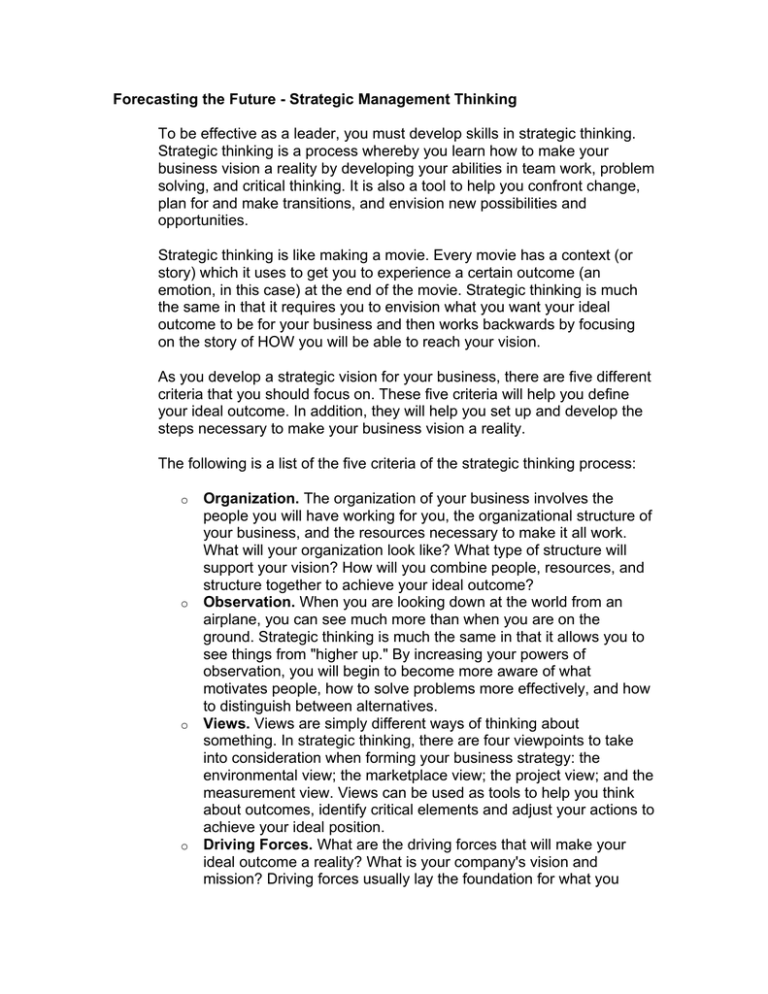Forecasting the Future - Strategic Management Thinking
advertisement

Forecasting the Future - Strategic Management Thinking To be effective as a leader, you must develop skills in strategic thinking. Strategic thinking is a process whereby you learn how to make your business vision a reality by developing your abilities in team work, problem solving, and critical thinking. It is also a tool to help you confront change, plan for and make transitions, and envision new possibilities and opportunities. Strategic thinking is like making a movie. Every movie has a context (or story) which it uses to get you to experience a certain outcome (an emotion, in this case) at the end of the movie. Strategic thinking is much the same in that it requires you to envision what you want your ideal outcome to be for your business and then works backwards by focusing on the story of HOW you will be able to reach your vision. As you develop a strategic vision for your business, there are five different criteria that you should focus on. These five criteria will help you define your ideal outcome. In addition, they will help you set up and develop the steps necessary to make your business vision a reality. The following is a list of the five criteria of the strategic thinking process: Organization. The organization of your business involves the people you will have working for you, the organizational structure of your business, and the resources necessary to make it all work. What will your organization look like? What type of structure will support your vision? How will you combine people, resources, and structure together to achieve your ideal outcome? o Observation. When you are looking down at the world from an airplane, you can see much more than when you are on the ground. Strategic thinking is much the same in that it allows you to see things from "higher up." By increasing your powers of observation, you will begin to become more aware of what motivates people, how to solve problems more effectively, and how to distinguish between alternatives. o Views. Views are simply different ways of thinking about something. In strategic thinking, there are four viewpoints to take into consideration when forming your business strategy: the environmental view; the marketplace view; the project view; and the measurement view. Views can be used as tools to help you think about outcomes, identify critical elements and adjust your actions to achieve your ideal position. o Driving Forces. What are the driving forces that will make your ideal outcome a reality? What is your company's vision and mission? Driving forces usually lay the foundation for what you o want people to focus on in your business (i.e., what you will use to motivate others to perform). Examples of driving forces might include: individual and organizational incentives; empowerment and alignment; qualitative factors such as a defined vision, values, and goals; productive factors like a mission or function; quantitative factors such as results or experience; and others such as commitment, coherent action, effectiveness, productivity, and value. o Ideal Position. After working through the first four phases of the strategic thinking process, you should be able to define your ideal position. Your ideal position outline should include: the conditions you have found to be necessary if your business is to be productive; the niche in the marketplace that your business will fill; any opportunities that may exist either currently or in the future for your business; the core competencies or skills required in your business; and the strategies and tactics you will use to pull it all together. By working through these five areas, you will begin to get a clearer picture of exactly how your business vision can be accomplished. As your vision becomes more focused, your ideas will appear stronger and more credible. Not only will it be easier to convince others that your idea is a good one, but it will also be easier to maintain your own conviction and motivation when you reach any pitfalls or obstacles in the road. Overall, you can apply strategic thinking skills to any area of your life. But by making a concerted effort to apply them specifically to your business venture, you will have a much better chance of bringing your vision to life. And isn't that what you want? For more information on strategic thinking and business planning, check out our Business Plan section.



